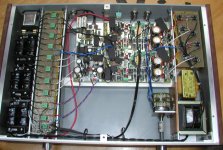In order to finance my non-oversampling projects, I decided to sell this David Broadhurst design based DAC. It's using CS8420, PDF1704 and parallel PCM1704 DAC chips (four in total, grade K).
Power supply featuring 6 split bobbin transformers, stack in pairs, for digital part (basically every chip and DAC's analog and digital side and the clock are using separate transformers with it's own full wave, soft recovery rectifiers). Digital PS contain 20 Sprague 1,800u Extralytics, which I believe is a best grade from Sprague.
Power supply featuring 6 split bobbin transformers, stack in pairs, for digital part (basically every chip and DAC's analog and digital side and the clock are using separate transformers with it's own full wave, soft recovery rectifiers). Digital PS contain 20 Sprague 1,800u Extralytics, which I believe is a best grade from Sprague.
Attachments
There are four PCM1704 DACs (2 per channel in parallel). They are treated as one as they are piggy backed on ea other with separate bypasses. Ea. channel's DAC analog and digital supply have separate reg. for a total of 8 LT (1085 and 1033) regulators. They are installed under the main PCB. As you notice I'm using Vishay resistors for I/V conversion, most of the resistors are Holcos with some Dales RN60, some MIT bypasses and MIT RTX input coupling caps (despite big size they sounded the best).
All bypass electrolytics are either Panasonic HFQ, Black Gates or Nichicon Gold.
I also did triple bypassing on all chips and the info is posted here:
http://www.diyaudio.com/forums/showthread.php?s=&threadid=6232&highlight=mods+never+end
All bypass electrolytics are either Panasonic HFQ, Black Gates or Nichicon Gold.
I also did triple bypassing on all chips and the info is posted here:
http://www.diyaudio.com/forums/showthread.php?s=&threadid=6232&highlight=mods+never+end
Attachments
What really suprises me about this project is that although I spent a lot of money and time trying to improve and tweak it, a simple non-oversampling DAC, with carefull attention to PS filtering and reclocking implemented, sounds better than the above posted effort using oversampling approach.
I still believe that this DAC could be further improved, by using different receiver and digital filter, or modifying existing setup and also improving the output stage, but for me it just doesn't appeal anymore.
My recent projects with non-oversampling designs show that this is actually more natural sounding approach and this is what I will pursue currently. I know there are many people who dismiss the non oversampling designs and maybe this DAC would be of interest to them. I'm not posting price and I'm open to offers.😉
I still believe that this DAC could be further improved, by using different receiver and digital filter, or modifying existing setup and also improving the output stage, but for me it just doesn't appeal anymore.
My recent projects with non-oversampling designs show that this is actually more natural sounding approach and this is what I will pursue currently. I know there are many people who dismiss the non oversampling designs and maybe this DAC would be of interest to them. I'm not posting price and I'm open to offers.😉
takashi said:HOW much ....... seems the price will be equal to my anual salary...
It depends where you live😉
Might be interested can you email me a price and an answer to the following question:
Can it be run on 240v?
thanks,
Brent
acworth@cit.gu.edu.au
Can it be run on 240v?
thanks,
Brent
acworth@cit.gu.edu.au
It can be run from 220 V with an external converter, I can provide. There are 8 transformers inside, and although six of them can be configured for 220V, the other two (analog output) cannot. I am looking at $1000 USD for that DAC. It is split 7/3 (approximately) between parts cost and my work.
DAC Sound
I am still as surprised as you are!.
Recently I had on audition in my home a Arcam Full Metal Jacket CD33 CDP and a Marantz SA17S1. The Marantz had a anomanaly in bass on CD's but sounded sweet on SACD.
The Arcam sounded like a typical upsampler, full of highs but NOT musical. My Philips CD-650/TDA1543 had the best bass and the most musical and natural sound. Too bad for my dealer, nothing sold.....
Will try a Audionote CD2 from an other dealer soon. Bizarre that it has a CS8414 on board!
😉
Hi Peter,Peter Daniel said:What really suprises me about this project is that although I spent a lot of money and time trying to improve and tweak it, a simple non-oversampling DAC, with carefull attention to PS filtering and reclocking implemented, sounds better than the above posted effort using oversampling approach.
I still believe that this DAC could be further improved, by using different receiver and digital filter, or modifying existing setup and also improving the output stage, but for me it just doesn't appeal anymore.
My recent projects with non-oversampling designs show that this is actually more natural sounding approach and this is what I will pursue currently. I know there are many people who dismiss the non oversampling designs and maybe this DAC would be of interest to them. I'm not posting price and I'm open to offers.😉
I am still as surprised as you are!.
Recently I had on audition in my home a Arcam Full Metal Jacket CD33 CDP and a Marantz SA17S1. The Marantz had a anomanaly in bass on CD's but sounded sweet on SACD.
The Arcam sounded like a typical upsampler, full of highs but NOT musical. My Philips CD-650/TDA1543 had the best bass and the most musical and natural sound. Too bad for my dealer, nothing sold.....
Will try a Audionote CD2 from an other dealer soon. Bizarre that it has a CS8414 on board!
😉
- Status
- Not open for further replies.






